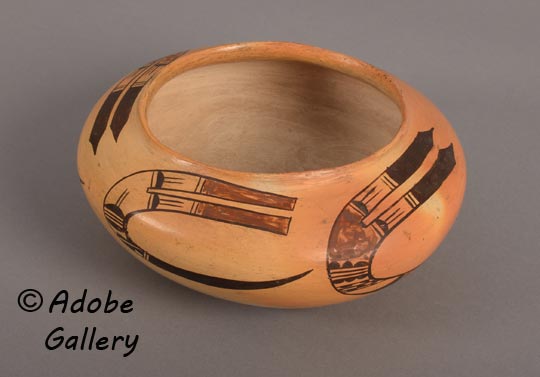Nampeyo of Hano Magnificent Low and Wide Pottery Jar
+ Add to my watchlist Forward to Friend
Forward to Friend
- Category: Historic
- Origin: Hopi Pueblo, Hopituh Shi-nu-mu
- Medium: clay, pigment
- Size: 3-½” height x 7-½” diameter
- Item # C4942H
- Price: $2950
 This small Hopi Polacca Polychrome seed jar, dating from the early 20th century, is a stunning example of a piece influenced by ancient Sikyatki pottery. Its low, wide body and refined shape are consistent with works by the renowned potter Nampeyo of Hano (1859-1942).
This small Hopi Polacca Polychrome seed jar, dating from the early 20th century, is a stunning example of a piece influenced by ancient Sikyatki pottery. Its low, wide body and refined shape are consistent with works by the renowned potter Nampeyo of Hano (1859-1942).
Painted on a yellow slip with mineral pigments, the design includes a serpentine motif that art historians have noted in Nampeyo's work from the 1912-1915 period. [Kramer 1996:187] It's a design that prompts curiosity — did the ancient Sikyatki people find inspiration in a celestial event, or perhaps the majestic flight of an eagle? While we may never know the answer, we can certainly appreciate its enduring beauty.
Nampeyo was a master at drawing inspiration from pottery shards found at the Sikyatki ruins, and she possessed a singular talent for applying long, elegant, curving strokes with a yucca leaf brush. This jar features four such designs, a testament to her skill.
Attributing a Potter's Legacy
Attributing a piece to a potter who worked over a century ago requires careful consideration of several factors. In Nampeyo's case, a strong attribution is possible for a number of reasons:
-
Distinctive Style: Nampeyo was a pioneer in reviving historic Sikyatki designs. She was arguably the first, and perhaps the only one, to consistently integrate these ancient patterns into her contemporary pottery.
-
Vessel Shape and Form: Her works are known for their symmetrical shapes, consistent wall thickness, and specific features like a short vertical neck and a rounded bottom. These characteristics, also found in this jar, align perfectly with her documented style.
-
Historical Documentation: Her work is abundant in museum collections, allowing for direct comparison. Additionally, the Fred Harvey Company at its Grand Canyon Hopi House famously attached paper labels to many of her pieces. This jar has one such label on the underside, a detail that adds strong support to the attribution. It also shows an original price of only $1.50.
Given the combination of its form, distinctive design, and the historical documentation, we are confident that this beautiful little jar was made by Nampeyo. It is an outstanding example of her extraordinary talent for both shaping a vessel and selecting an appropriate, elegant design.
Condition: very good condition
Provenance: this Nampeyo of Hano Magnificent Low and Wide Pottery Jar isfrom the collection of a client of Adobe Gallery
Reference: Kramer, Barbara. "Nampeyo and Her Pottery" New Mexico Press, Albuquerque. 1996
TAGS: Hopi Pueblo, Fannie Polacca Nampeyo, Nellie Nampeyo Douma, Annie Healing Nampeyo, Nampeyo of Hano, Fred Harvey Company

- Category: Historic
- Origin: Hopi Pueblo, Hopituh Shi-nu-mu
- Medium: clay, pigment
- Size: 3-½” height x 7-½” diameter
- Item # C4942H
- Price: $2950
Adobe Gallery Recommended Reading
Adobe Gallery Recommended Items
If you are interested in this item, we would also like to recommend these other related items:



